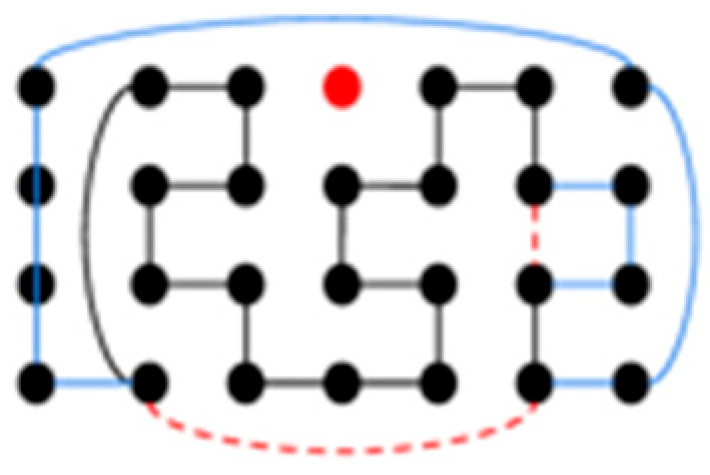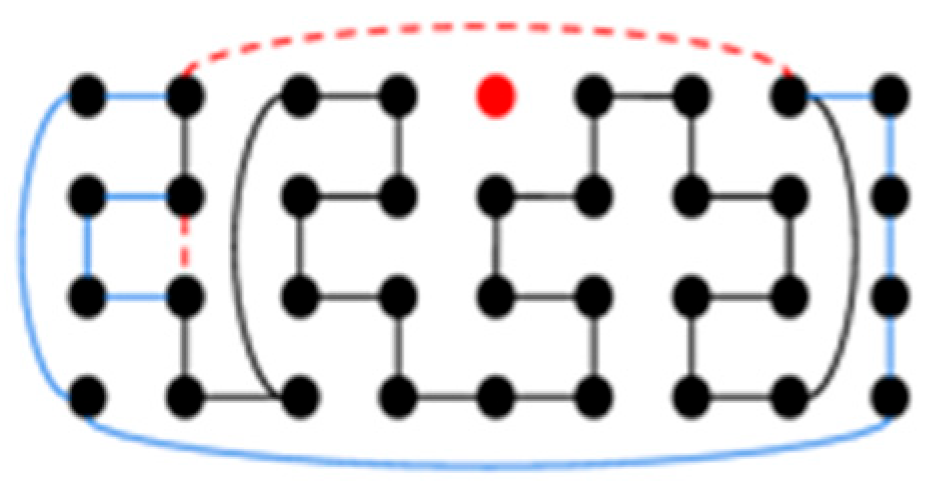One-Node One-Edge Dimension-Balanced Hamiltonian Problem on Toroidal Mesh Graph †
Abstract
1. Introduction
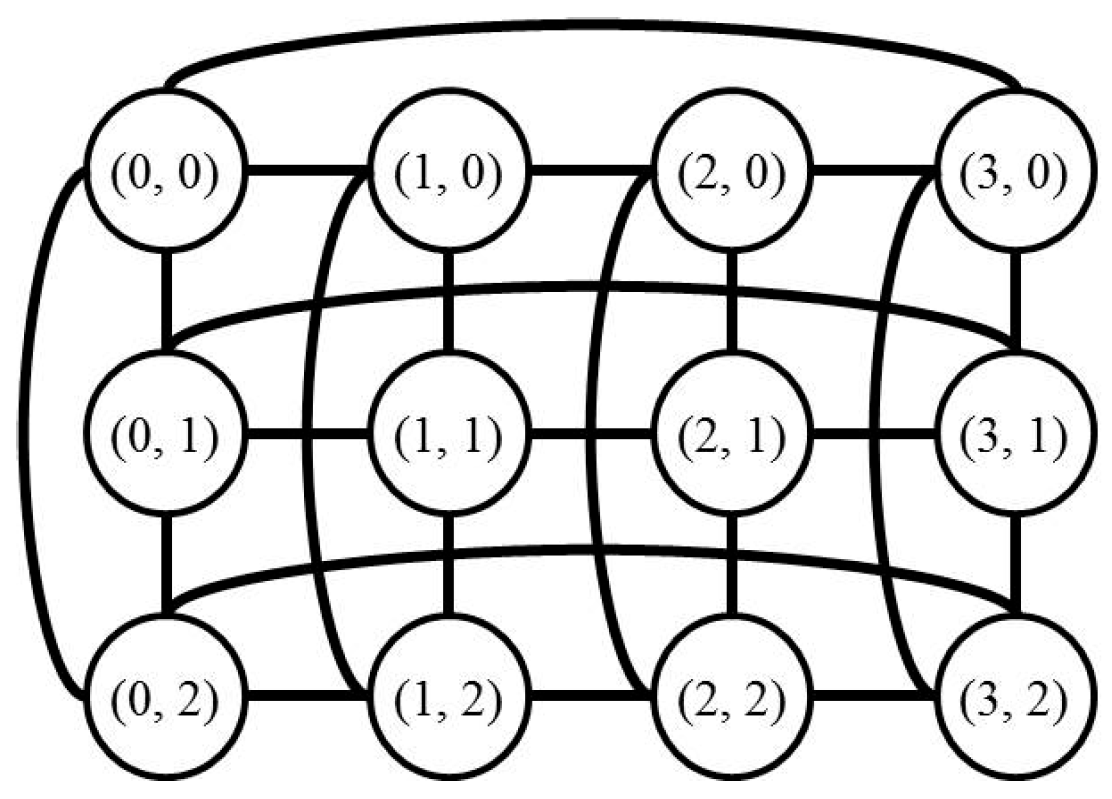
2. Preliminaries
3. Main Results

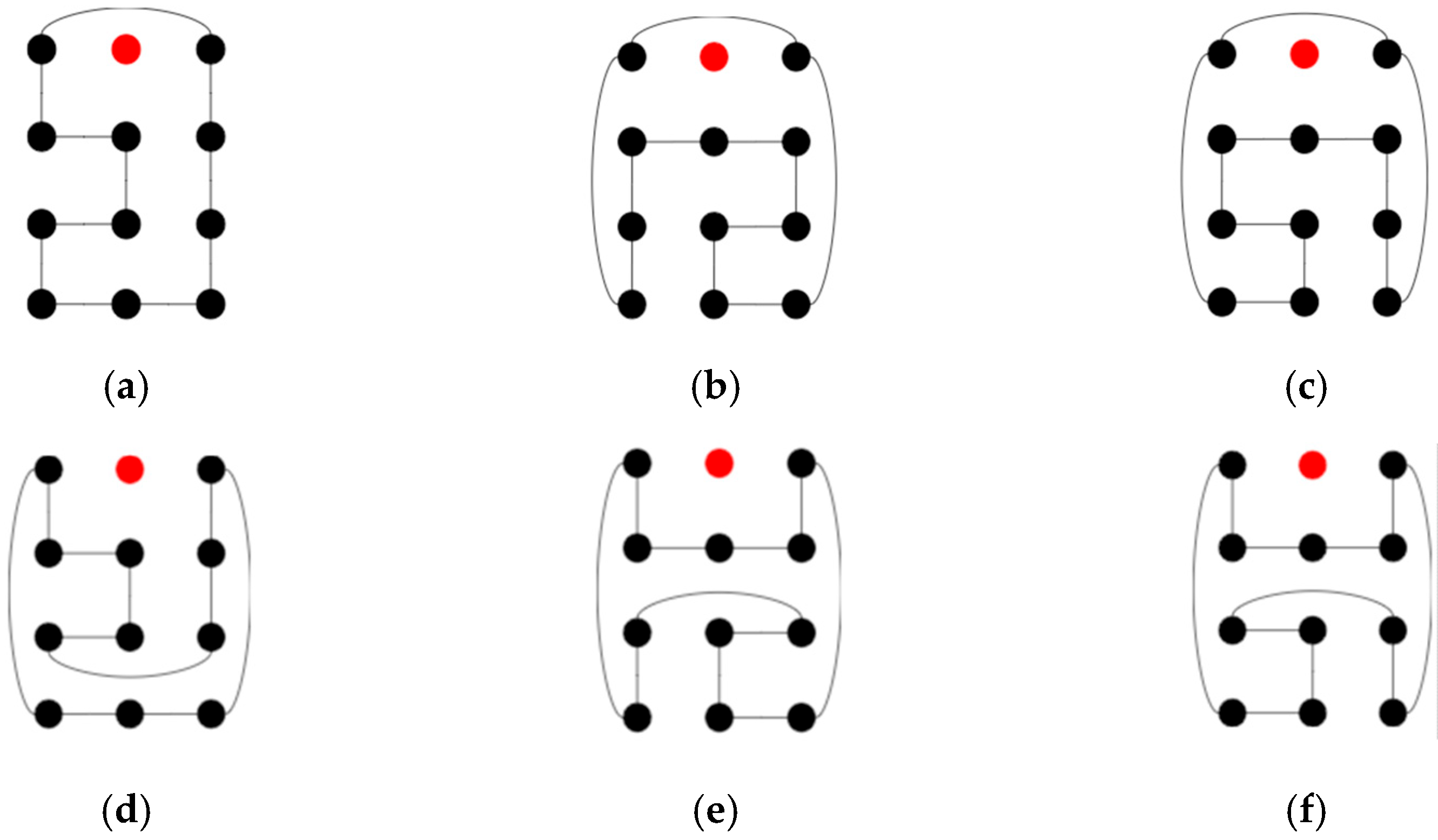
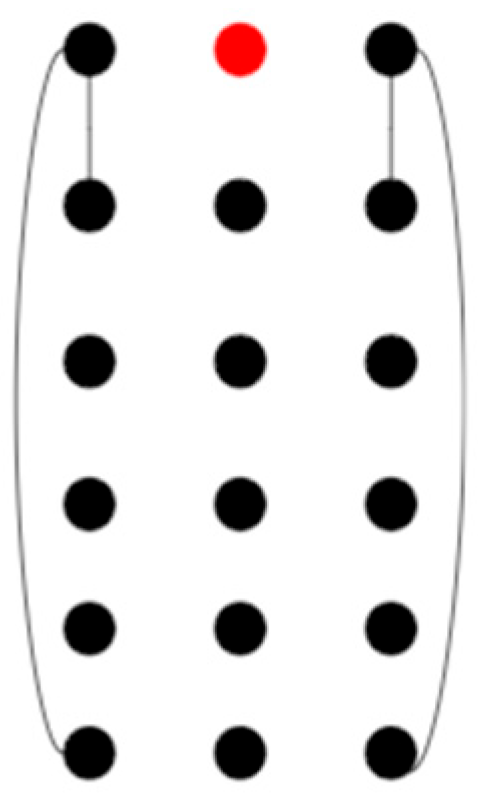
- Step 1. One column is expanded to both the left and right of Tm−2,4: In this step, there exists a DBH on Tm,4 − F, which is proved by induction. Claim 1 is proved as follows.
- Claim 1: |E1(C1)| = |E1(C2)| = ⌊(mn − 1)/2 ⌋ and |E2(C1)| = |E2(C2)| = ⌈(mn − 1)/2⌉.
- Case 1. (m mod 4) = 3: There are two DBHs on Tm,4 to be constructed. Therefore, this case is divided into two parts and discussed separately depending on whether the constructed DBH is type (a) or type (b).
- Case 1.1. To construct a DBH with type (a): In the hypothesis, there is a DBH C1 on Tm−2,4 with type (a) satisfying Claim 1. First, C1 is put in the middle of Tm,4 with edges {(1, 0)(1, 3), (1, 3)(m − 2, 3), (m − 2, 0)(m − 2, 1), (m − 2, 1)(m − 2, 2)}, (m − 2, 2)(m − 2, 3)} in C1. Then, remove {(1, 3)(m − 2, 3), (m − 2, 1)(m − 2, 2)} from C1 and add {(m − 2, 1)(m − 1, 1), (m − 1, 1)(m − 1, 2), (m − 2, 2)(m − 1, 2), (m − 2, 3)(m − 1, 3), (m − 1, 0)(m − 1, 3), (0, 0)(m − 1, 0), (0, 0)(0, 1), (0, 1)(0, 2), (0, 2)(0, 3), (0, 3)(1, 3)} into C1. After calculation, the operation requires adding four first-dimensional edges and four second-dimensional edges. We removed one first-dimensional edge and one second-dimensional edge and added five first-dimensional edges and five second-dimensional edges. Therefore, the constructed Hamiltonian cycle is of type (a), satisfies Claim 1, and is a DBH. Figure 6 shows an example of T7,4 − F.Figure 6. The constructed DBH C1 on T7,4 − F.
- Case 1.2. To construct a DBH with type (b): There is a DBH C2 on Tm−2,4 with type (b) and that satisfies Claim 1. First, C2 is put in the middle of Tm,4, with edge {(1, 1)(m − 2, 1)} in C2. Then, {(1, 0)(1, 3), (1, 1)(m − 2, 1)} is removed to add {(0, 0)(1, 0), (0, 1)(1, 1), (0, 1)(0, 2), (0, 2)(m − 1, 2), (0, 3)(1, 3), (0, 0)(0, 3), (m − 2, 1)(m − 1, 1), (m − 1, 0)(m − 1, 1), (m − 1, 0)(m − 1, 3), (m − 1, 2)( m − 1, 3)}. After calculation, this operation requires adding four first-dimensional edges and four second-dimensional edges. We removed one first-dimensional and one second-dimensional edges and added five first-dimensional edges and five second-dimensional edges. Therefore, the constructed Hamiltonian cycle becomes type (b), satisfies Claim 1, and is a DBH. Figure 7 shows an example of the constructed C2 on T7,4 − F.Figure 7. Constructed DBH C2 on T7,4 − F.
- Case 2. (m mod 4) = 1: There are also two DBHs on Tm,4 need to be constructed. Therefore, this case is divided into two parts and discussed separately depending on whether the constructed DBH is type (a) or (b).
- Case 2.1. To construct a DBH with type (a), a DBH C1 is used on Tm−2,4 with type (a) satisfying Claim 1. C1 is similar to Figure 6 in this subcase. First, C1 is put in the middle of Tm,4 with edges {(1, 0)(1, 1), (1, 1)(1, 2), (1, 2)(1, 3), (1, 0)(m − 2, 0), (m − 2, 0)(m − 2, 3)} in C1. Then, remove {(1, 0)(m − 2, 0), (1, 1)(1, 2)} and add {(0, 0)(1, 0), (0, 1)(1, 1), (0, 1)(0, 2), (0, 2)(1, 2), (0, 0)(0, 3), (0, 3)(m − 1, 3), (m − 2, 0)(m − 1, 0), (m − 1, 0)(m − 1, 1), (m − 1, 1)(m − 1, 2), (m − 1, 2)(m − 1, 3)} into C1. After calculation, this operation requires adding four first-dimensional edges and four second-dimensional edges. Similarly to case 1.1, we removed one first-dimensional edge and one second-dimensional edge and added five first-dimensional edges and five second-dimensional edges. Therefore, the constructed Hamiltonian cycle is of type (a), satisfies Claim 1, and is a DBH. Figure 8 shows an example of the constructed C1 on T9,4 − F.Figure 8. The constructed DBH C1 of T9,4 − F.
- Case 2.2. To construct a DBH with type (b): There is a DBH C2 on Tm−2,4 with type (b) satisfying Claim 1. C2 is similar to Figure 7 in this subcase. First, C2 is put in the middle of Tm,4 with edge {(1, 2)(m − 2, 2)} in C2. Then, remove {(1, 0)(1, 3), (1, 2)(m − 2, 2)} and add {(0, 0)(1, 0), (0, 1)(0, 2), (0, 1)(m − 1, 1), (0, 2)(1, 2), (0, 3)(1, 3), (0, 0)(0, 3), (m − 2, 2)(m − 1, 2), (m − 1, 0)(m − 1, 1), (m − 1, 0)(m − 1, 3), (m − 1, 2)(m − 1, 3)}. Again, it can be determined that this operation requires adding four first-dimensional edges and four second-dimensional edges into C2 to keep it dimension-balanced. We removed one first-dimensional edge and one second-dimensional edge and added five first-dimensional edges and five second-dimensional edges. Therefore, the constructed Hamiltonian cycle is of type (b) satisfying Claim 1 and a DBH. Figure 9 shows an example of the constructed C2 on T9,4 − F.Figure 9. The constructed DBH C2 of T9,4 − F.
- Step 2. Two rows downward of Tm,n−2.
- Case 1. (m mod 4) = 1: There are two DBHs on Tm,n to be constructed. Therefore, this case is divided into two parts and discussed separately depending on whether the constructed DBH is type (a) or (b).
- Case 1.1. To construct a DBH with type (a): By Step 1, there is a DBH C1 on Tm,4 with type (a). Copy the last two rows of C1 to be a subgraph of Ym named Zm. Figure 10a,b show Z5 and Z9, respectively. Now, C1 is put in the upper part of Tm,n, and k Zms in the lower part of Tm,n. Then, remove {(0, 3)(m − 1, 3)} ∪ {(2i, 0)(2i, 3), (2i + 1, 3 + 2j)(2i + 2, 3 + 2j) | 0 ≤ i < (m − 1)/4, 0 ≤ j < k} ∪ {(2i + 1, 0)(2i + 1, 3) | (m + 3)/4 ≤ i < (m − 1)/2} and add {(2i, 0)(2i, n − 1), (2i, 3 + 2j)(2i, 4 + 2j), (2i, 3 + 2j)(2i + 1, 3 + 2j) | 0 ≤ i < (m − 1)/4, 0 ≤ j < k } ∪ {(2i + 1, 0)(2i + 1, n − 1), (2i + 1, 3 + 2j)(2i + 1, 4 + 2j) | (m + 3)/4 ≤ i < (m − 1)/2, 0 ≤ j < k} ∪ {((m − 1)/2, 3 + 2j)((m − 1)/2, 4 + 2j), (m − 1, 3 + 2j)(m − 1, 4 + 2j) | 0 ≤ j < k}. Figure 10c,d show examples for T5,6 − F, T9,6 − F. After calculation, the generated Hamiltonian cycle C satisfies |E1(C)| = |E1(C1)| + k(m − 1) = nm/2 − (k + 1) and |E2(C)| = |E1(C1)| + k(m + 1) = nm/2 + k. We added k or k + 1 first-dimensional edges and removed k or k + 1 second-dimensional edges from C to form a type (a) DBH of Tm,n − F. There are two sub-steps according to the value of n that can solve this situation.
- Step 1.1.1. Let x = ⌊(n + 2)/8⌋ = ⌊(k + 3)/4⌋. Find x smallest i with {(0, i)(0, i + 1), (m − 1, i)(m − 1, i + 1)} ⊆ E(C). Then, remove (0, i)(0, i + 1), (m − 1, i)(m − 1, i + 1) and add (0, i)(m − 1, i), (0, i + 1)(m − 1, i + 1) to C. Figure 10e shows an example for T5,6 − F. This step adds 2⌊(k + 3)/4⌋ first-dimensional edge and removes 2⌊(k + 3)/4⌋ second-dimensional edges from C.
- Step 1.1.2. Let x = ⌊(n − 2)/8⌋ = ⌊(k + 1)/4⌋. Find x smallest i with {(m − 2, i)(m − 2, i + 1), (m − 1, i)(m − 1, i + 1)} ⊆ E(C) and {(m − 2, i)(m − 1, i), (m − 2, i + 1)(m − 1, i + 1)} ⊄ E(C). Then, (m − 2, i)(m − 2, i + 1), (m − 1, i)(m − 1, i + 1) are removed, and (m − 2, i)(m − 1, i), (m − 2, i + 1)(m − 1, i + 1) are added into C. Figure 10f shows an example. This step adds 2⌊(k + 1)/4⌋ first-dimensional edges and removes 2⌊(k + 1)/4⌋ second-dimensional edges from C.
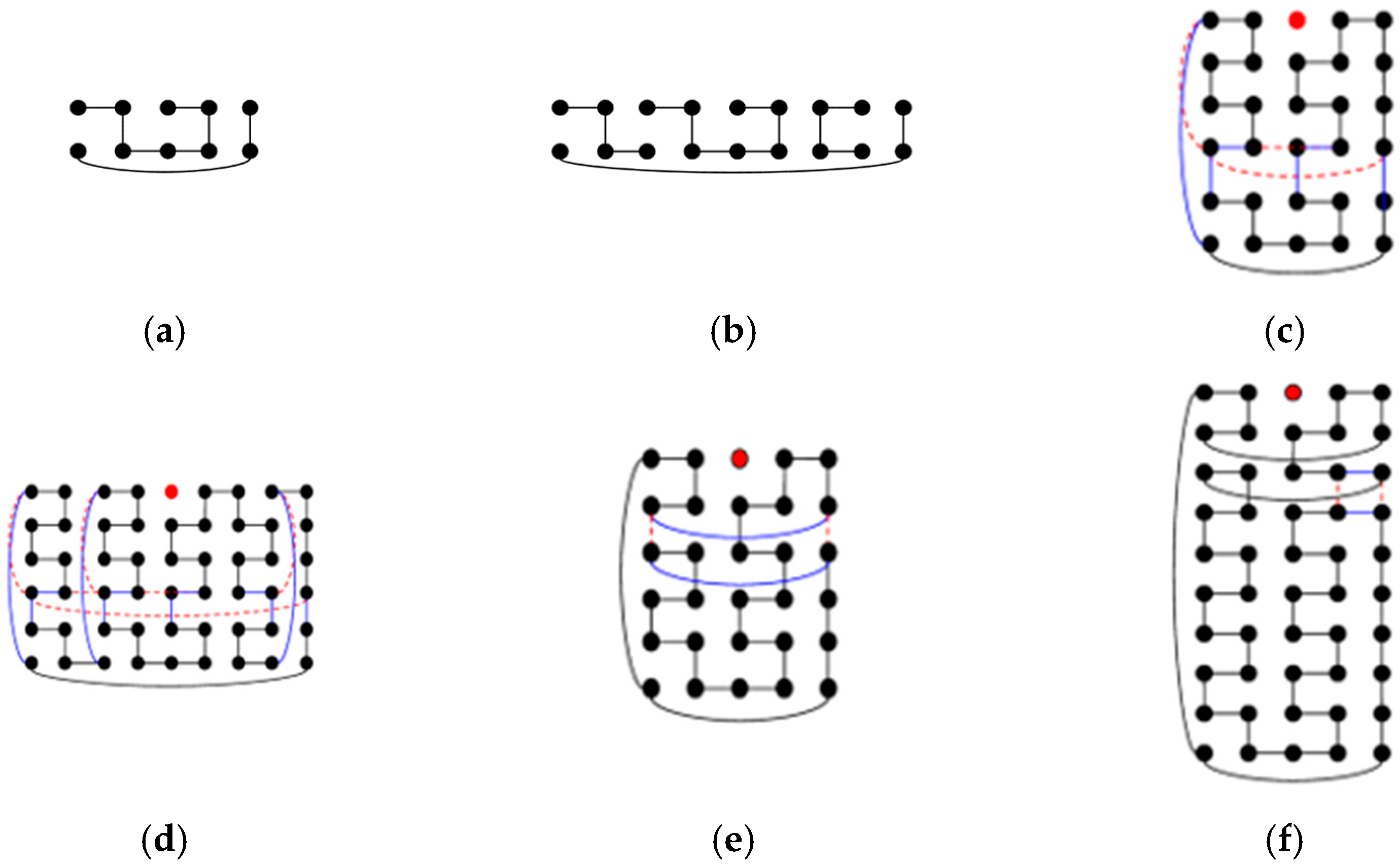
- Case 1.2. To construct a DBH with type (b): By Step 1, there is a DBH C2 on Tm,4 with type (b). The last two rows of C2 are copied to be a subgraph of Ym named Zm. Modify Zm by adding edges {(0, 2i + 1)(0, 2i + 2) | 0 ≤ i ≤ (m − 9)/4} and deleting edges {(0, (m − 5)/2)(0, (m − 3)/2} ∪ {(0, 2i)(0, 2i + 1) | (m + 5)/4 ≤ i ≤ (m − 2)/2}. Figure 10a,b show Z5 and Z9, respectively. Then, C2 is put in the upper part of Tm,n, and k Zms in the lower part of Tm,n. Then, for any 0 ≤ i ≤ m − 1, if edge (0, i)(3, i) is in C2, this edge is removed, and edges {(0, i)(n − 1, i), (3 + 2j, i)(4 + 2j, i) | 0 ≤ j < k} are added to C2 and k Zms to form a new Hamiltonian cycle C of Tm,n − F. Figure 11c,d show an example of T5,6 − F and T9,6 − F. Similarly to case 1.1, after calculation, the generated Hamiltonian cycle C satisfies |E1(C)| = |E1(C1)| + k(m − 1) = nm/2 − (k + 1) and |E2(C)| = |E1(C1)| + k(m + 1) = nm/2 + k. We added k or k + 1 first-dimensional edges and removed k or k + 1 second-dimensional edges from C to form a type (b) DBH of Tm,n − F. There are two sub-steps according to the value of n to solve this situation. m = 5 is a special case and needs to be discussed separately.
- Step 1.2.1. Let x = ⌊(n + 2)/8⌋ = ⌊(k + 3)/4⌋. For m = 5, find x smallest i with {(0, i)(0, i + 1), (m − 1, i)(m − 1, i + 1)} ⊆ E(C). Then, remove these two edges and add (0, i)(m − 1, i), (0, i + 1)(m − 1, i + 1) into C. Figure 11e shows an example. For m > 5, find x smallest i with {((m − 1)/2 + 2, i)((m − 1)/2 + 2, i + 1), ((m − 1)/2 + 3, i)((m − 1)/2 + 3, i + 1)} ⊆ E(C). Then, these two edges are removed, and ((m − 1)/2 + 2, i)((m − 1)/2 + 3, i), ((m − 1)/2 + 2, i + 1)((m − 1)/2 + 3, i + 1) are added to C. Figure 11f shows an example for T9,6 − F.
- Step 1.2.2. Let x = ⌊(n − 2)/8⌋ = ⌊(k + 1)/4⌋. For m = 5, find the 2x edges (0, i)(0, i + 1), (1, i)(1, i + 1) such that (0, i)(1, i), (0, i + 1)(1, i + 1) ∉ E(C) (after performing Step 1.2.1). Then, (0, i)(0, i + 1), (1, i)(1, i + 1) are removed, and (0, i)(1, i), (0, i + 1)(1, i + 1) are added to C. Figure 11g shows an example for T5,10 − F. For m > 5, find the 2x edges ((m − 1)/2 + 3, i)((m − 1)/2 + 3, i + 1), ((m − 1)/2 + 4, i)((m − 1)/2 + 4, i + 1) such that ((m − 1)/2 + 3, i)((m − 1)/2 + 4, i), ((m − 1)/2 + 3, i + 1)((m − 1)/2 + 4, i + 1) ∉ E(C) and i > 0. Then, ((m − 1)/2 + 3, i)((m − 1)/2 + 3, i + 1), ((m − 1)/2 + 4, i)((m − 1)/2 + 4, i + 1) are removed, and ((m − 1)/2 + 3, i)((m − 1)/2 + 4, i), ((m − 1)/2 + 3, i + 1)((m − 1)/2 + 4, i + 1) are added to C. Figure 11f shows an example for T9,10 − F.
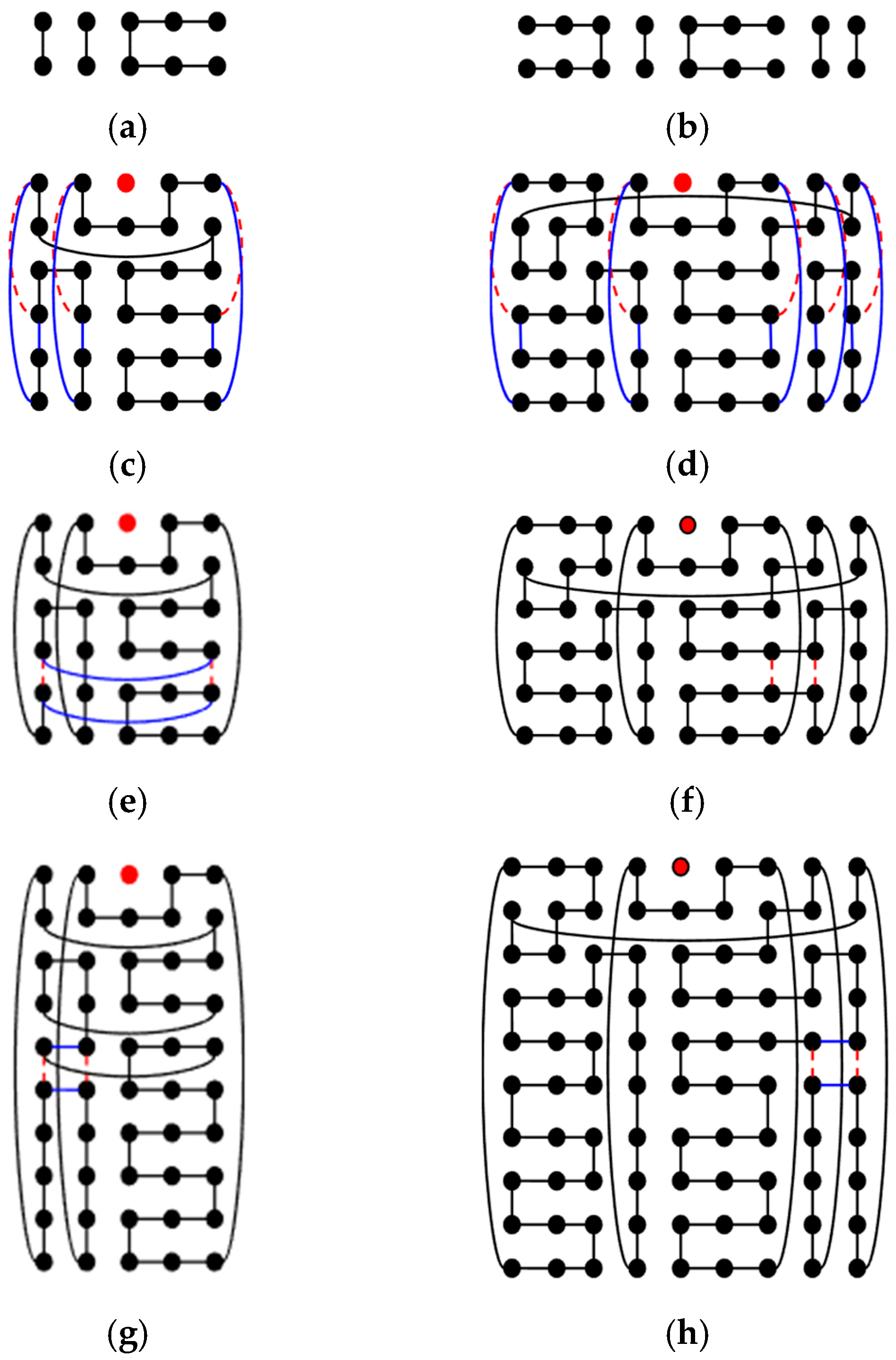
- Case 2. (m mod 4) = 3: There are two DBHs on Tm,n constructed. Therefore, this case is divided into two parts and discussed separately depending on whether the constructed DBH is type (a) or type (b).
- Case 2.1. To construct a DBH with type (a): By Step 1, there is a DBH C1 on Tm,n−2 with type (a). The last two rows of C1 are copied to be a subgraph of Ym named Zm. Figure 12a,b show that Z7 and Z11. C1 are put in the upper part of Tm,n, and k Zms in the lower part of Tm,n. Then, {(1 + 2i, 0)(1 + 2i, 3), (m − 1 − 2i, 0)(m − 1 − 2i, 3)| 0 ≤ i < (m − 3)/4} ∪ {(2i, 3 + 2j)(2i + 1, 3 + 2j)| 0 ≤ i < (m + 1)/4, 0 ≤ j < k} are removed, and {(1 + 2i, 0)(1 + 2i, n − 1), (m − 1 − 2i, 0)(m − 1 − 2i, n − 1), (1 + 2i, 3 + 2j)(2 + 2i, 3 + 2j), (1 + 2i, 3 + 2j)(1 + 2i, 4 + 2j), (m − 1 − 2i, 3 + 2j)(m − 1 − 2i, 4 + 2j)| 0 ≤ i < (m − 3)/4, 0 ≤ j < k } ∪ {((m − 1)/2, 3 + 2j)((m − 1)/2, 4 + 2j), (0, 3 + 2j)(0, 4 + 2j) | 0 ≤ j < k} are added. Figure 12c,d show T7,6 − F and T11,6 − F. After calculation, the generated Hamiltonian cycle C will satisfy |E1(C)| = |E1(C1)| + k(m − 1) = nm/2 − (k + 1) and |E2(C)| = |E2(C1)| + k(m + 1) = nm/2 + k. We added k or k + 1 first-dimensional edges and removed k or k + 1 second-dimensional edges from C to form a type (a) DBH of Tm,n − F. There are two sub-steps according to the value of n that can solve this situation.
- Step 2.1.1. Let x = ⌊(n + 2)/8⌋ = ⌊(k + 3)/4⌋. First, {(0, 4i + 1)(0, 4i + 2), (m − 1, 4i + 1)(m − 1, 4i + 2) | 0 ≤ i < x} are removed from C, and then {(0, 4i + 1)(m − 1, 4i + 1), (0, 4i + 2)(m − 1, 4i + 2) | 0 ≤ i < x} are added to C. Figure 12e shows an example for T7,6 − F. In total, 2⌊(k + 3)/4⌋ first-dimensional edges are added to remove 2⌊(k + 3)/4⌋ second-dimensional edges from C.
- Step 2.1.2. Let x = ⌊(n − 2)/8⌋ = ⌊(k + 1)/4⌋. Then, {(0, 4i + 3)(0, 4i + 4), (1, 4i + 3)(1, 4i + 4) | 0 ≤ i < x} are removed from C, and {(0, 4i + 3)(1, 4i + 3), (0, 4i + 4)(1, 4i + 4) | 0 ≤ i < x} are added to C. Figure 12f shows an example of T7,10 − F. This step adds 2⌊(k + 1)/4⌋ first-dimensional edges and removes 2⌊(k + 1)/4⌋ second-dimensional edges from C.
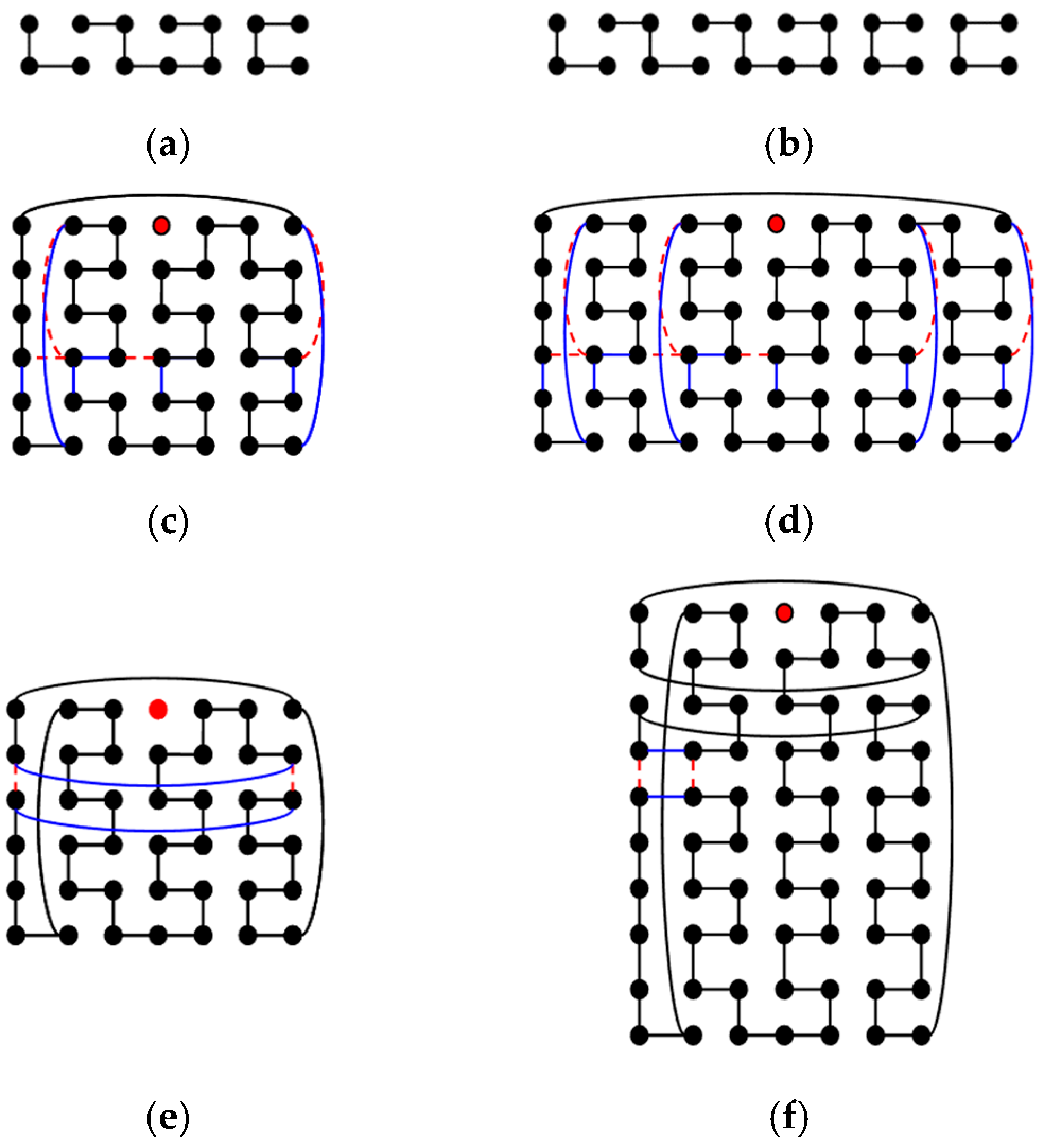
- Case 2.2. To construct a DBH with type (b): By Step 1, there is a DBH C2 on Tm,4 with type (b). The last two rows of C2 are copied to be a subgraph of Ym named Zm. Zm is modified by adding edges {(0, 2i)(0, 2i + 1) | 0 ≤ i ≤ (m − 7)/4} and deleting edges {(0, (m − 5)/2)(0, (m − 3)/2} ∪ {(0, 2i)(0, 2i + 1) | (m + 5)/4 ≤ i ≤ (m − 3)/2}. Figure 13a,b show Z7 and Z11, respectively. Then, C2 is put in the upper part of Tm,n, and k Zms in the lower part of Tm,n. Then, for any 0 ≤ i ≤ m − 1, if edge (0, i)(3, i) is in C2, then this edge is removed to add edges {(0, i)(n − 1, i), (3 + 2j, i)(4 + 2j, i) | 0 ≤ j < k} into C2 and k Zms to form a new Hamiltonian cycle C of Tm,n − F. Figure 13c,d show examples of T7,6 − F and T11,6 − F. Similarly to case 2.1, after calculation, the generated Hamiltonian cycle C satisfies |E1(C)| = |E1(C1)| + k(m − 1) = nm/2 − (k + 1) and |E2(C)| = |E1(C1)| + k(m + 1) = nm/2 + k. We added k or k + 1 first-dimensional edges and removed k or k + 1 second-dimensional edges from C to form a type (b) DBH of Tm,n − F. There are two sub-steps according to the value of n to solve this problem.
- Step 2.2.1. Let x = ⌊(n + 2)/8⌋ = ⌊(k + 3)/4⌋. Find the x smallest i with {(0, i)(0, i + 1), (m − 1, i)(m − 1, i + 1)} ⊆ E(C). Then, these two edges are removed, and (0, i)(m − 1, i), (0, i + 1)(m − 1, i + 1) are added to C. Figure 13e shows an example of T7,6 − F.
- Step 2.2.2. Let x = ⌊(n − 2)/8⌋ = ⌊(k + 1)/4⌋. Find the x edge pairs ((m − 1)/2 − 2, i)((m − 1)/2 − 2, i + 1), ((m − 1)/2 − 1, i)((m − 1)/2 − 1, i + 1) such that ((m − 1)/2 − 2, i)((m − 1)/2 − 1, i), ((m − 1)/2 − 2, i + 1)((m − 1)/2 − 1, i + 1) ∉ E(C), and i > 3. Then, ((m − 1)/2 − 2, i)((m − 1)/2 − 2, i + 1), ((m − 1)/2 − 1, i)((m − 1)/2 − 1, i + 1) are removed, and ((m − 1)/2 − 2, i)((m − 1)/2 − 1, i), ((m − 1)/2 − 2, i + 1)((m − 1)/2 − 1, i + 1) are added to C. Figure 13f shows an example of T7,10 − F.
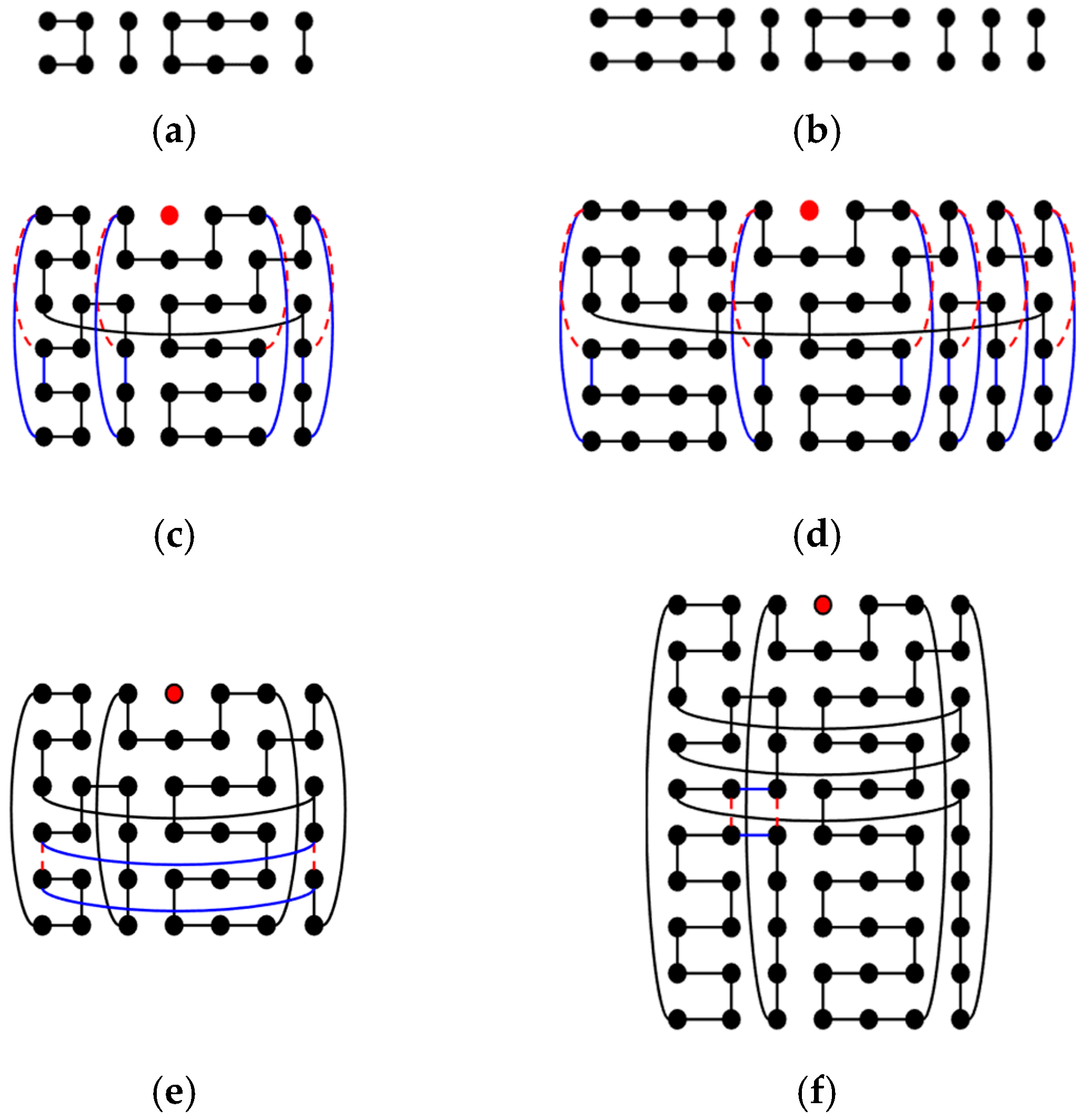
4. Conclusions
| m = 3 | m Is Odd (>3) | m = 4 | m Is Even (>4) | |
|---|---|---|---|---|
| n = 3 | Yes (Thm 3) | No (Thm 3) | Yes (Thm 3) | No (Thm 3) |
| n is odd (>3) | No (Thm 3) | No (Conjecture 1) | Yes (Thm 4) | |
| n = 4 | Yes (Thm 3) | Yes (Thm 4) | No (Thm 1) | |
| n is even (>4) | No (Thm 3) | |||
Author Contributions
Funding
Institutional Review Board Statement
Informed Consent Statement
Data Availability Statement
Conflicts of Interest
References
- Dimakopoulos, V.V.; Palios, L.; Poulakidas, A.S. On the Hamiltonicity of the Cartesian Product. Inform. Process. Lett. 2005, 96, 49–53. [Google Scholar] [CrossRef]
- Kim, H.-C.; Park, J.-H. Fault Hamiltonicity of Two-Dimensional Torus Networks. In Proceedings of the Workshop on Algorithms and Computation WAAC’00, Tokyo, Japan, 21–22 July 2000; pp. 110–117. [Google Scholar]
- Du, Z.-Z.; Xu, J.-M. A Note on Cycle Embedding in Hypercubes with Faulty Vertices. Inf. Process. Lett. 2011, 111, 557–560. [Google Scholar] [CrossRef]
- Wang, H.-R. The Balanced Hamiltonian Cycle Problem. Master’s Thesis, Department of Computer Science and Information Engineering, National Chi-Nan University, Nantou, Taiwan, 2011. [Google Scholar]
- Peng, W.-F.; Juan, J.S.-T. The Balanced Hamiltonian Cycle on the Toroidal Mesh Graphs. World Academy of Science, Engineering and Technology, Open Science Index 65. Int. J. Comput. Inf. Eng. 2012, 6, 674–680. [Google Scholar]
- Wu, R.-Y.; Lai, Z.-Y.; Juan, J.S.-T. The Weakly Dimension-Balanced Hamiltonian. In Proceedings of the International Conference on Parallel and Distributed Processing Techniques and Applications (PDPTA), Las Vegas, NV, USA, 30 July–2 August 2018; pp. 178–182. [Google Scholar]
- Juan, J.S.-T.; Lai, Z.-Y. The Weakly Dimension-Balanced Pancyclicity on Toroidal Mesh Graph Tm,n When Both m and n Are Odd. In Lecture Notes in Computer Science; Springer: Cham, Switzerland, 2021; Volume 13025, pp. 437–448. [Google Scholar]
- Hsu, H.-C.; Chiang, L.-C.; Tan, J.J.; Hsu, L.-H. Fault hamiltonicity of augmented cubes. Parallel Comput. 2005, 31, 131–145. [Google Scholar] [CrossRef]
- Cheng, C.-W.; Lee, C.-W.; Hsieh, S.-Y. Conditional Edge-Fault Hamiltonicity of Cartesian Product Graphs. IEEE Trans. Parallel Distrib. Syst. 2013, 24, 1951–1960. [Google Scholar] [CrossRef]
- Abdallah, M.; Cheng, E. Fault-Tolerant Hamiltonian Connectivity of 2-Tree-Generated Networks. Theor. Comput. 2022, 907, 62–81. [Google Scholar] [CrossRef]
- Juan, J.S.-T.; Ciou, H.-C.; Lin, M.-J. The One-Fault Dimension-Balanced Hamiltonian Problem on Toroidal Mesh Graph. Symmetry 2005, 17, 93. [Google Scholar] [CrossRef]
- Xu, J. Theory and Application of Graphs; Kluwer Academic Publishers: Norwell, MA, USA, 2003. [Google Scholar]
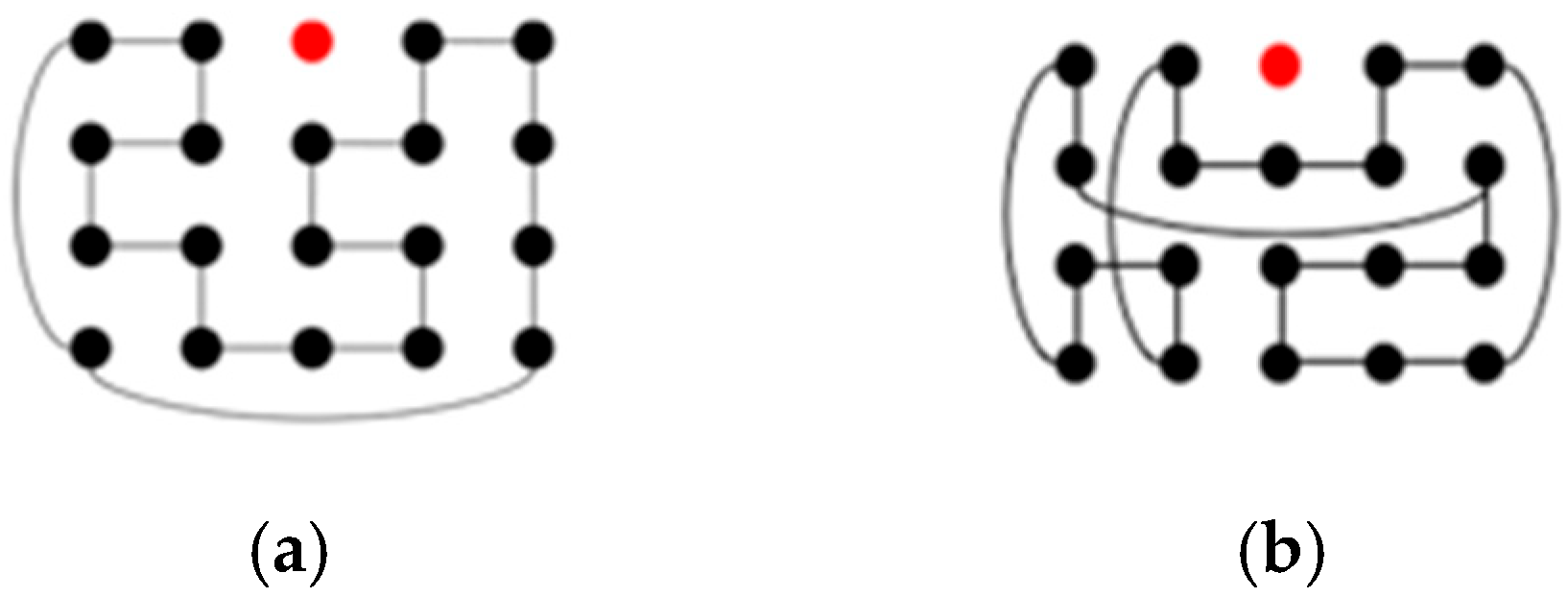
Disclaimer/Publisher’s Note: The statements, opinions and data contained in all publications are solely those of the individual author(s) and contributor(s) and not of MDPI and/or the editor(s). MDPI and/or the editor(s) disclaim responsibility for any injury to people or property resulting from any ideas, methods, instructions or products referred to in the content. |
© 2025 by the authors. Licensee MDPI, Basel, Switzerland. This article is an open access article distributed under the terms and conditions of the Creative Commons Attribution (CC BY) license (https://creativecommons.org/licenses/by/4.0/).
Share and Cite
Chang, Y.Y.-C.; Juan, J.S.-T. One-Node One-Edge Dimension-Balanced Hamiltonian Problem on Toroidal Mesh Graph. Eng. Proc. 2025, 89, 17. https://doi.org/10.3390/engproc2025089017
Chang YY-C, Juan JS-T. One-Node One-Edge Dimension-Balanced Hamiltonian Problem on Toroidal Mesh Graph. Engineering Proceedings. 2025; 89(1):17. https://doi.org/10.3390/engproc2025089017
Chicago/Turabian StyleChang, Yancy Yu-Chen, and Justie Su-Tzu Juan. 2025. "One-Node One-Edge Dimension-Balanced Hamiltonian Problem on Toroidal Mesh Graph" Engineering Proceedings 89, no. 1: 17. https://doi.org/10.3390/engproc2025089017
APA StyleChang, Y. Y.-C., & Juan, J. S.-T. (2025). One-Node One-Edge Dimension-Balanced Hamiltonian Problem on Toroidal Mesh Graph. Engineering Proceedings, 89(1), 17. https://doi.org/10.3390/engproc2025089017






